Page 12 of 490
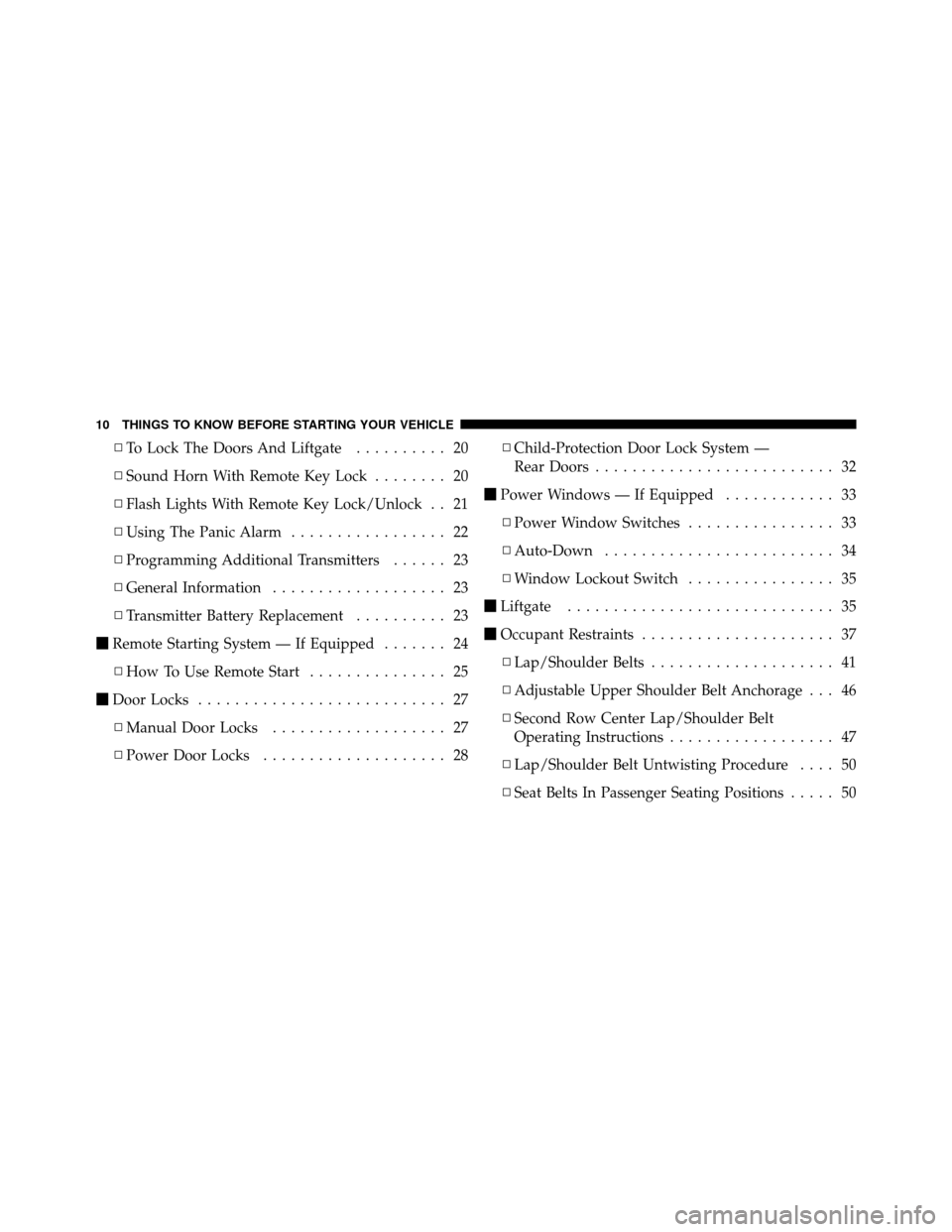
▫To Lock The Doors And Liftgate .......... 20
▫ Sound Horn With Remote Key Lock ........ 20
▫ Flash Lights With Remote Key Lock/Unlock . . 21
▫ Using The Panic Alarm ................. 22
▫ Programming Additional Transmitters ...... 23
▫ General Information ................... 23
▫ Transmitter Battery Replacement .......... 23
� Remote Starting System — If Equipped ....... 24
▫ How To Use Remote Start ............... 25
� Door Locks ........................... 27
▫ Manual Door Locks ................... 27
▫ Power Door Locks .................... 28 ▫
Child-Protection Door Lock System —
Rear Doors .......................... 32
� Power Windows — If Equipped ............ 33
▫ Power Window Switches ................ 33
▫ Auto-Down ......................... 34
▫ Window Lockout Switch ................ 35
� Liftgate ............................. 35
� Occupant Restraints ..................... 37
▫ Lap/Shoulder Belts .................... 41
▫ Adjustable Upper Shoulder Belt Anchorage . . . 46
▫ Second Row Center Lap/Shoulder Belt
Operating Instructions .................. 47
▫ Lap/Shoulder Belt Untwisting Procedure .... 50
▫ Seat Belts In Passenger Seating Positions ..... 50
10 THINGS TO KNOW BEFORE STARTING YOUR VEHICLE
Page 13 of 490
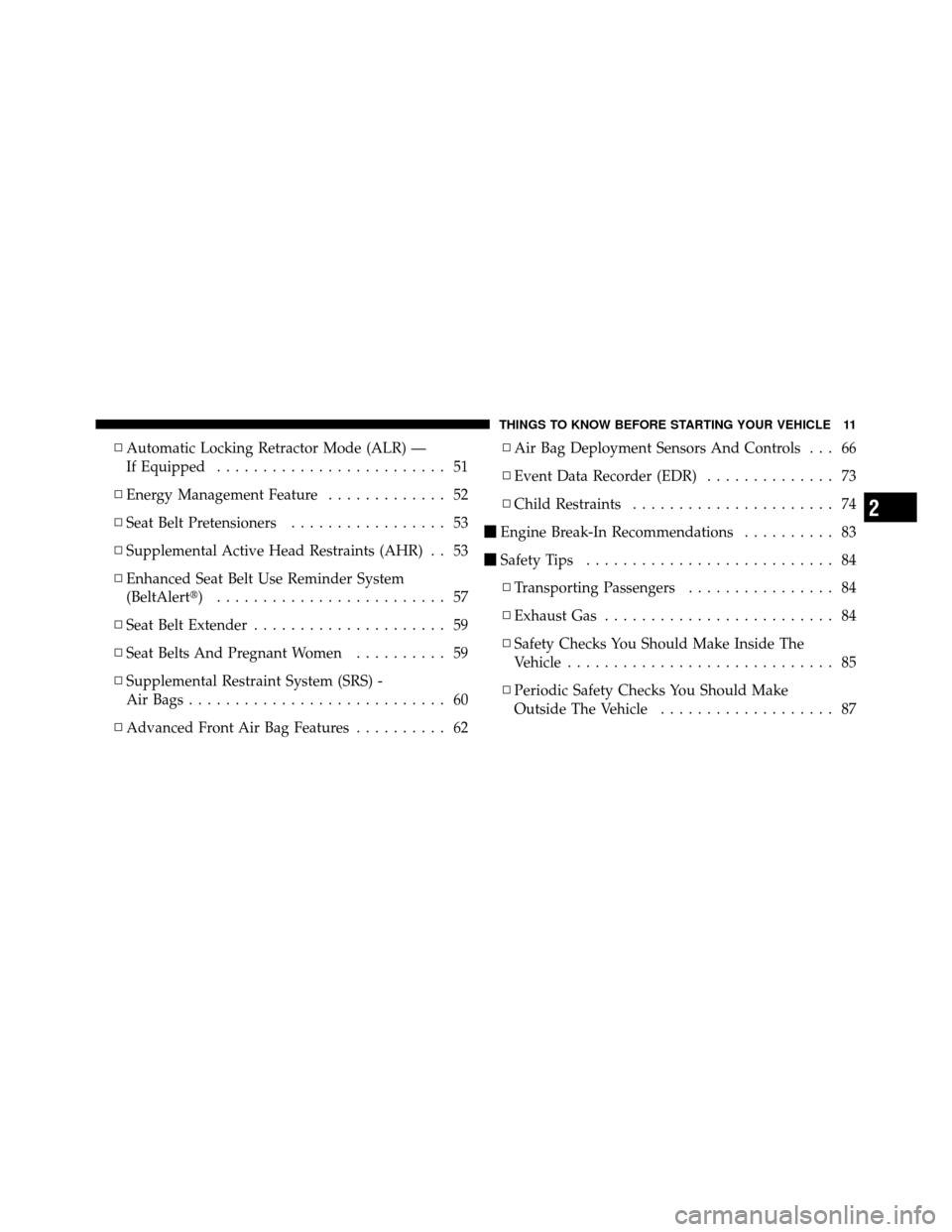
▫Automatic Locking Retractor Mode (ALR) —
If Equipped ......................... 51
▫ Energy Management Feature ............. 52
▫ Seat Belt Pretensioners ................. 53
▫ Supplemental Active Head Restraints (AHR) . . 53
▫ Enhanced Seat Belt Use Reminder System
(BeltAlert�) ......................... 57
▫ Seat Belt Extender ..................... 59
▫ Seat Belts And Pregnant Women .......... 59
▫ Supplemental Restraint System (SRS) -
Air Bags ............................ 60
▫ Advanced Front Air Bag Features .......... 62▫
Air Bag Deployment Sensors And Controls . . . 66
▫ Event Data Recorder (EDR) .............. 73
▫ Child Restraints ...................... 74
� Engine Break-In Recommendations .......... 83
� Safety Tips ........................... 84
▫ Transporting Passengers ................ 84
▫ Exhaust Gas ......................... 84
▫ Safety Checks You Should Make Inside The
Vehicle ............................. 85
▫ Periodic Safety Checks You Should Make
Outside The Vehicle ................... 87
2
THINGS TO KNOW BEFORE STARTING YOUR VEHICLE 11
Page 34 of 490
Child-Protection Door Lock System —
Rear Doors
To provide a safer environment for small children riding
in the rear seats, the rear doors are equipped with
Child-Protection Door Lock system.
To Engage Or Disengage The Child-Protection
Door Lock System
1. Open the rear door.
2. Insert the tip of the ignition key into the lock and
rotate to the LOCK or UNLOCK position.
3. Repeat steps 1 and 2 for the opposite rear door.
Child-Protection Door Lock Location
32 THINGS TO KNOW BEFORE STARTING YOUR VEHICLE
Page 40 of 490
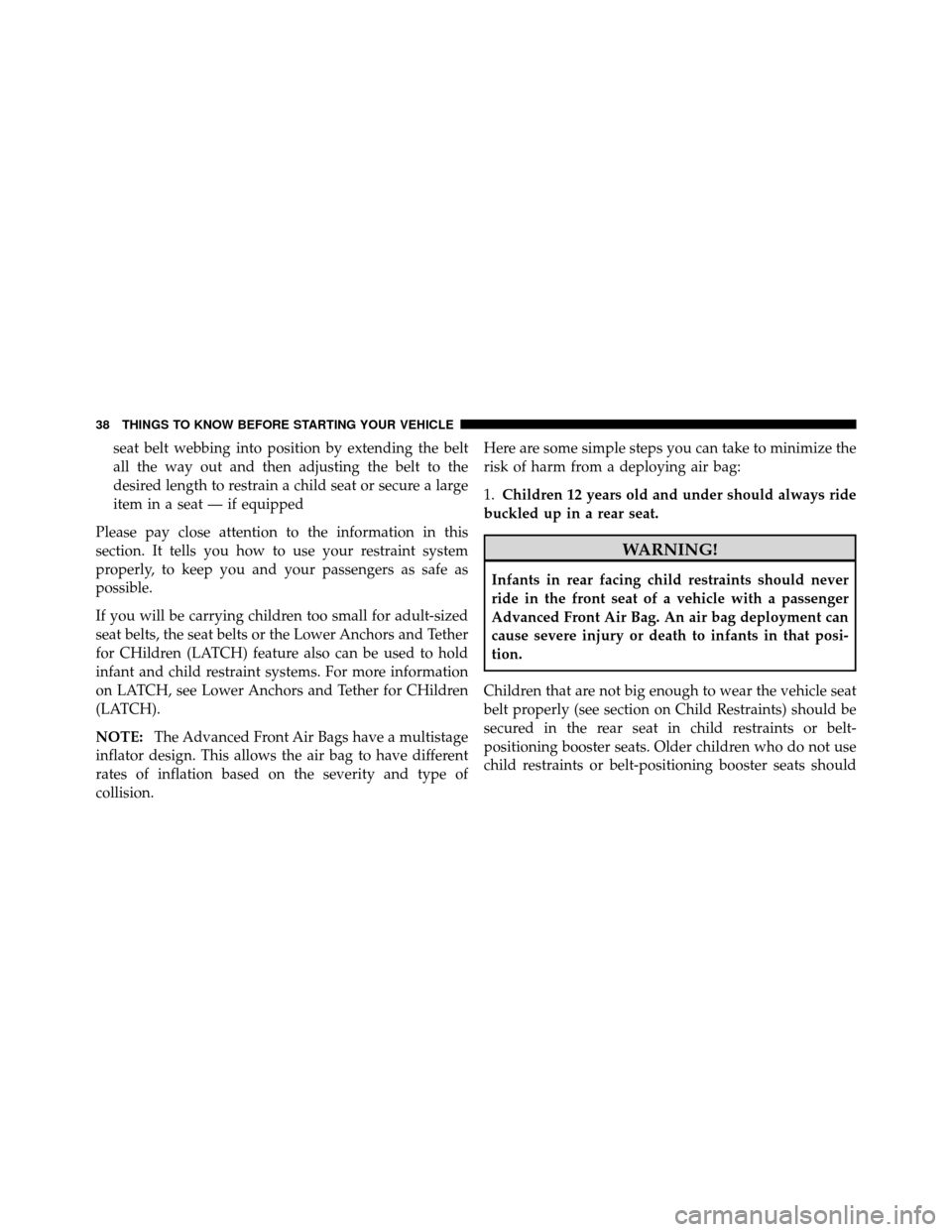
seat belt webbing into position by extending the belt
all the way out and then adjusting the belt to the
desired length to restrain a child seat or secure a large
item in a seat — if equipped
Please pay close attention to the information in this
section. It tells you how to use your restraint system
properly, to keep you and your passengers as safe as
possible.
If you will be carrying children too small for adult-sized
seat belts, the seat belts or the Lower Anchors and Tether
for CHildren (LATCH) feature also can be used to hold
infant and child restraint systems. For more information
on LATCH, see Lower Anchors and Tether for CHildren
(LATCH).
NOTE: The Advanced Front Air Bags have a multistage
inflator design. This allows the air bag to have different
rates of inflation based on the severity and type of
collision. Here are some simple steps you can take to minimize the
risk of harm from a deploying air bag:
1.
Children 12 years old and under should always ride
buckled up in a rear seat.
WARNING!
Infants in rear facing child restraints should never
ride in the front seat of a vehicle with a passenger
Advanced Front Air Bag. An air bag deployment can
cause severe injury or death to infants in that posi-
tion.
Children that are not big enough to wear the vehicle seat
belt properly (see section on Child Restraints) should be
secured in the rear seat in child restraints or belt-
positioning booster seats. Older children who do not use
child restraints or belt-positioning booster seats should
38 THINGS TO KNOW BEFORE STARTING YOUR VEHICLE
Page 41 of 490

ride properly buckled up in the rear seat. Never allow
children to slide the shoulder belt behind them or under
their arm.
If a child from 1 to 12 years old (not in a rear facing child
seat) must ride in the front passenger seat, move the seat
as far back as possible and use the proper child restraint.
(Refer to “Child Restraints”)
You should read the instructions provided with your
child restraint to make sure that you are using it properly.
2.All occupants should always wear their lap and
shoulder belts properly.
3. The driver and front passenger seats should be
moved back as far as practical to allow the Advanced
Front Air Bags room to inflate. 4.
Do not lean against the door or window. If your
vehicle has side air bags, and deployment occurs, the
side air bags will inflate forcefully into the space
between you and the door.
5. If the air bag system in this vehicle needs to be
modified to accommodate a disabled person, contact
the Customer Center. Phone numbers are provided
under �If You Need Assistance�.
WARNING!
•Relying on the air bags alone could lead to more
severe injuries in a collision. The air bags work
with your seat belt to restrain you properly. In
some collisions, the air bags won’t deploy at all.
Always wear your seat belts even though you have
air bags.
(Continued)
2
THINGS TO KNOW BEFORE STARTING YOUR VEHICLE 39
Page 52 of 490

10. To disengage the mini-latch from the mini-buckle for
storage, insert the regular latch plate into the black
button on the top of the mini-buckle. The belt will
automatically retract to its stowed position. If necessary,
slide the latch plate down the webbing to allow the belt
to retract fully. Insert the mini-latch plate into the slot
provided in the trim panel.
Lap/Shoulder Belt Untwisting Procedure
Use the following procedure to untwist a twisted lap/
shoulder belt.
1. Position the latch plate as close as possible to the
anchor point.
2. At about 6 to 12 in (15 to 30 cm) above the latch plate,
grasp and twist the belt webbing 180 degrees to create a
fold that begins immediately above the latch plate.3. Slide the latch plate upward over the folded webbing.
The folded webbing must enter the slot at the top of the
latch plate.
4. Continue to slide the latch plate up until it clears the
folded webbing.
Seat Belts In Passenger Seating Positions
The seat belts in the passenger seating positions are
equipped with Automatic Locking Retractors (ALR)
which are used to secure a child restraint system. For
additional information, refer to “Installing Child Re-
straints Using The Vehicle Seat Belt” under the “Child
Restraints” section. The chart below defines the type of
feature for each seating position.
50 THINGS TO KNOW BEFORE STARTING YOUR VEHICLE
Page 53 of 490
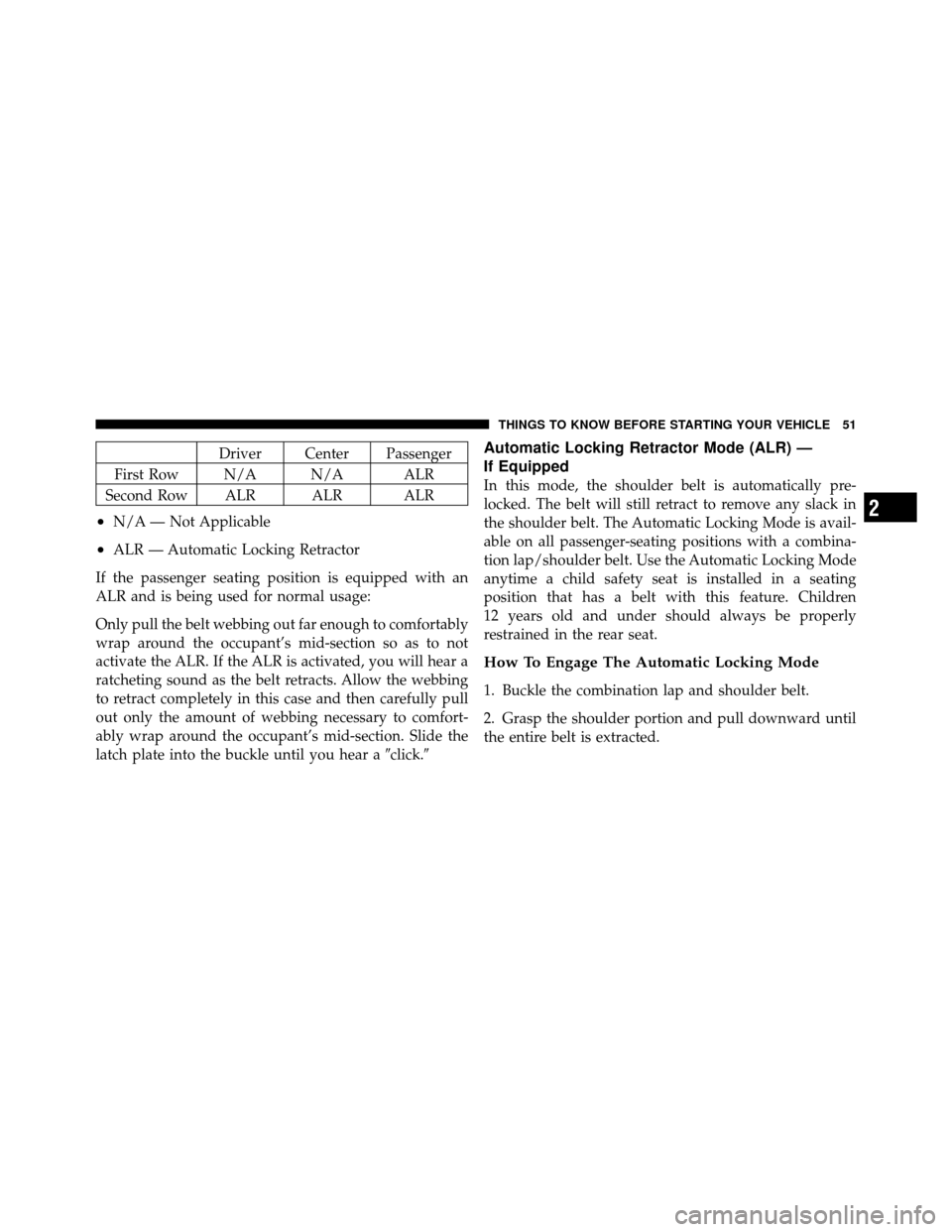
Driver Center Passenger
First Row N/A N/A ALR
Second Row ALR ALR ALR
•N/A — Not Applicable
•ALR — Automatic Locking Retractor
If the passenger seating position is equipped with an
ALR and is being used for normal usage:
Only pull the belt webbing out far enough to comfortably
wrap around the occupant’s mid-section so as to not
activate the ALR. If the ALR is activated, you will hear a
ratcheting sound as the belt retracts. Allow the webbing
to retract completely in this case and then carefully pull
out only the amount of webbing necessary to comfort-
ably wrap around the occupant’s mid-section. Slide the
latch plate into the buckle until you hear a �click.�
Automatic Locking Retractor Mode (ALR) —
If Equipped
In this mode, the shoulder belt is automatically pre-
locked. The belt will still retract to remove any slack in
the shoulder belt. The Automatic Locking Mode is avail-
able on all passenger-seating positions with a combina-
tion lap/shoulder belt. Use the Automatic Locking Mode
anytime a child safety seat is installed in a seating
position that has a belt with this feature. Children
12 years old and under should always be properly
restrained in the rear seat.
How To Engage The Automatic Locking Mode
1. Buckle the combination lap and shoulder belt.
2. Grasp the shoulder portion and pull downward until
the entire belt is extracted.
2
THINGS TO KNOW BEFORE STARTING YOUR VEHICLE 51
Page 55 of 490
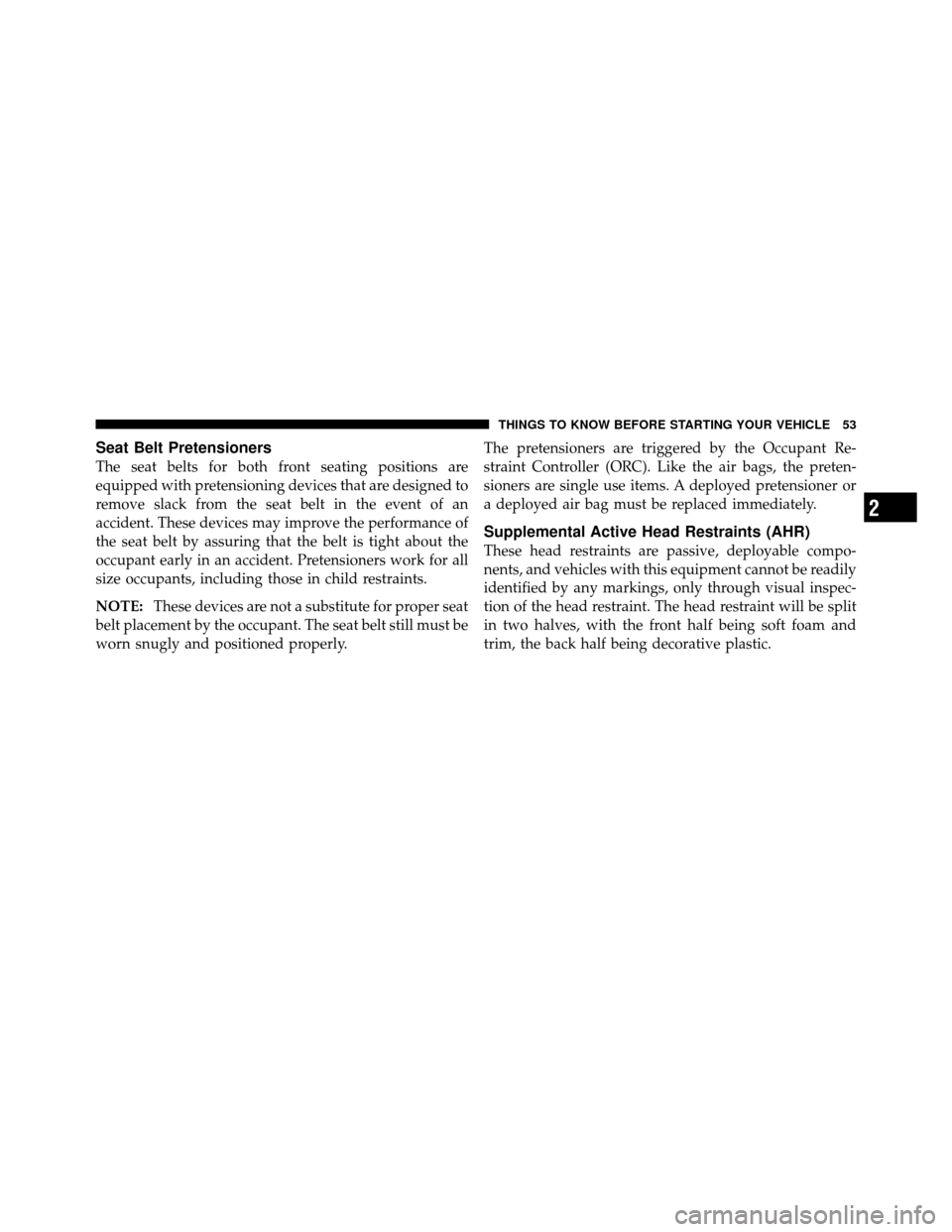
Seat Belt Pretensioners
The seat belts for both front seating positions are
equipped with pretensioning devices that are designed to
remove slack from the seat belt in the event of an
accident. These devices may improve the performance of
the seat belt by assuring that the belt is tight about the
occupant early in an accident. Pretensioners work for all
size occupants, including those in child restraints.
NOTE:These devices are not a substitute for proper seat
belt placement by the occupant. The seat belt still must be
worn snugly and positioned properly. The pretensioners are triggered by the Occupant Re-
straint Controller (ORC). Like the air bags, the preten-
sioners are single use items. A deployed pretensioner or
a deployed air bag must be replaced immediately.
Supplemental Active Head Restraints (AHR)
These head restraints are passive, deployable compo-
nents, and vehicles with this equipment cannot be readily
identified by any markings, only through visual inspec-
tion of the head restraint. The head restraint will be split
in two halves, with the front half being soft foam and
trim, the back half being decorative plastic.
2
THINGS TO KNOW BEFORE STARTING YOUR VEHICLE 53